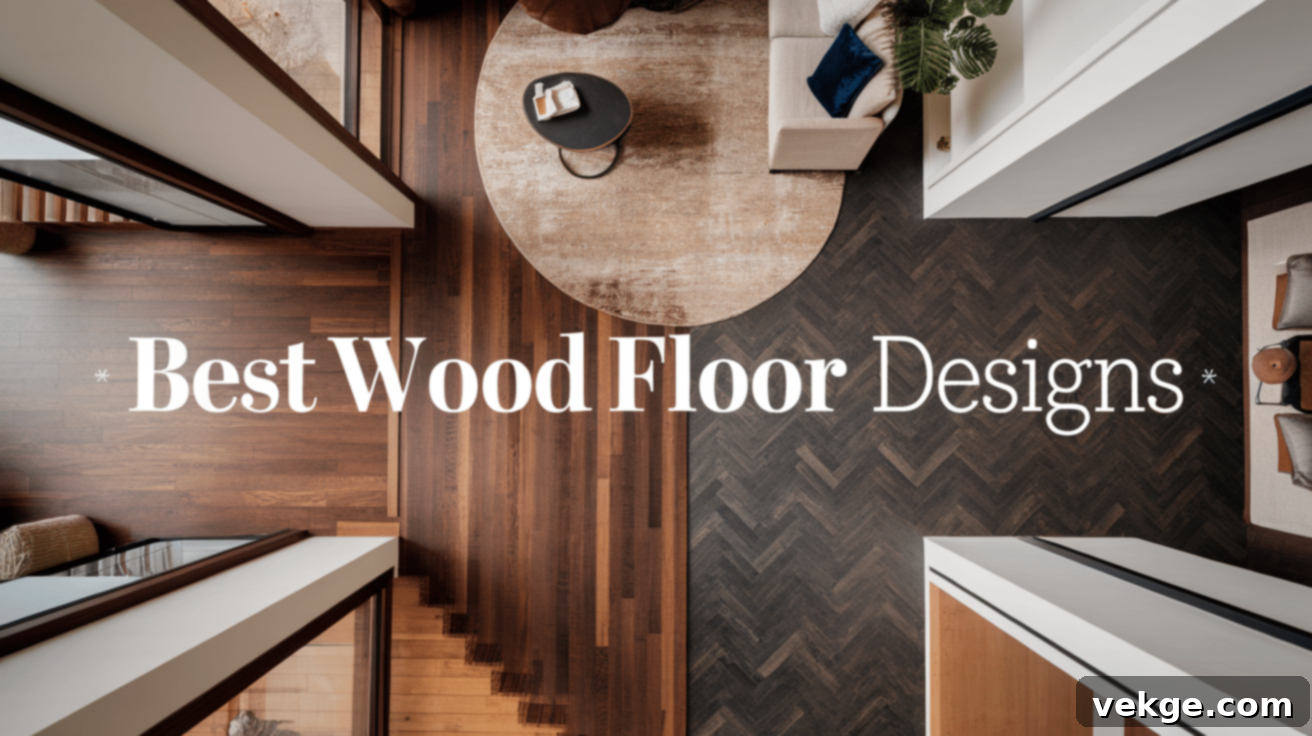Discover the Best Wood Floor Designs: Your Ultimate Guide to Timeless Elegance and Modern Style
Wood floors have an unparalleled ability to transform any home, instantly adding a sense of warmth, sophistication, and inviting appeal. Beyond their aesthetic charm, they offer remarkable durability and versatility, adapting seamlessly to various interior design themes, from cozy farmhouse to sleek modern minimalist. With an expansive array of styles, finishes, and patterns available, choosing the perfect wood flooring can feel like a daunting task.
Whether you’re drawn to the rustic charm of wide planks, the intricate elegance of herringbone, or the contemporary allure of gray-washed finishes, there’s a wood floor design perfectly suited to your taste and lifestyle. This comprehensive guide will walk you through some of the most popular and impactful wood floor designs, helping you understand their unique characteristics, benefits, and considerations. The right flooring can significantly alter the perception of a room, enhancing its natural light, making it feel more expansive, or deepening its sense of intimacy.
Investing in the right wood flooring is more than just a home improvement project; it’s an investment in the long-term beauty and value of your space. Keep reading to explore our top recommendations and find the ideal wood floor design that will elevate your home’s aesthetic and stand the test of time.
Why Choose Wood Floors? The Enduring Appeal of Hardwood
Wood flooring remains a perennial favorite among homeowners for a multitude of compelling reasons. Its natural beauty is matched by practical benefits that make it an excellent long-term investment for any property. Here’s why hardwood continues to be a leading choice:
- Durability: High-quality wood floors are renowned for their longevity. With proper installation and care, they can easily last for decades, often outliving other flooring types. Many hardwood floors can even be refinished multiple times, extending their life and allowing for periodic style updates.
- Easy Maintenance: Unlike carpets that trap dust and allergens, wood floors are remarkably easy to keep clean. Regular sweeping, vacuuming, and occasional damp mopping are usually sufficient to maintain their pristine appearance, making them a hygienic choice for busy households.
- Versatility: Wood flooring is incredibly adaptable, complementing virtually any interior design scheme. Whether your home leans towards traditional elegance, modern minimalism, rustic farmhouse, or coastal chic, there’s a wood species, stain, and finish that will seamlessly integrate and enhance your decor.
- Value Addition: Installing wood floors is a proven way to increase your home’s resale value. Prospective buyers often view hardwood as a premium feature, appreciating its durability, timeless appeal, and low maintenance requirements, making your property more attractive in the market.
- Eco-friendliness: Many modern wood flooring options are sourced from sustainably managed forests or are made from reclaimed and recycled wood. This makes them an environmentally conscious choice, reducing demand for new resources and promoting a circular economy.
Before diving into specific designs, it’s crucial to consider factors such as room size, existing home style, and the anticipated level of foot traffic. Understanding these elements will help you make an informed decision that ensures both beauty and functionality. Now, let’s explore the best wood floor designs available to inspire your next home renovation!
Best Wood Floor Designs for Your Home
1. Classic Hardwood Planks
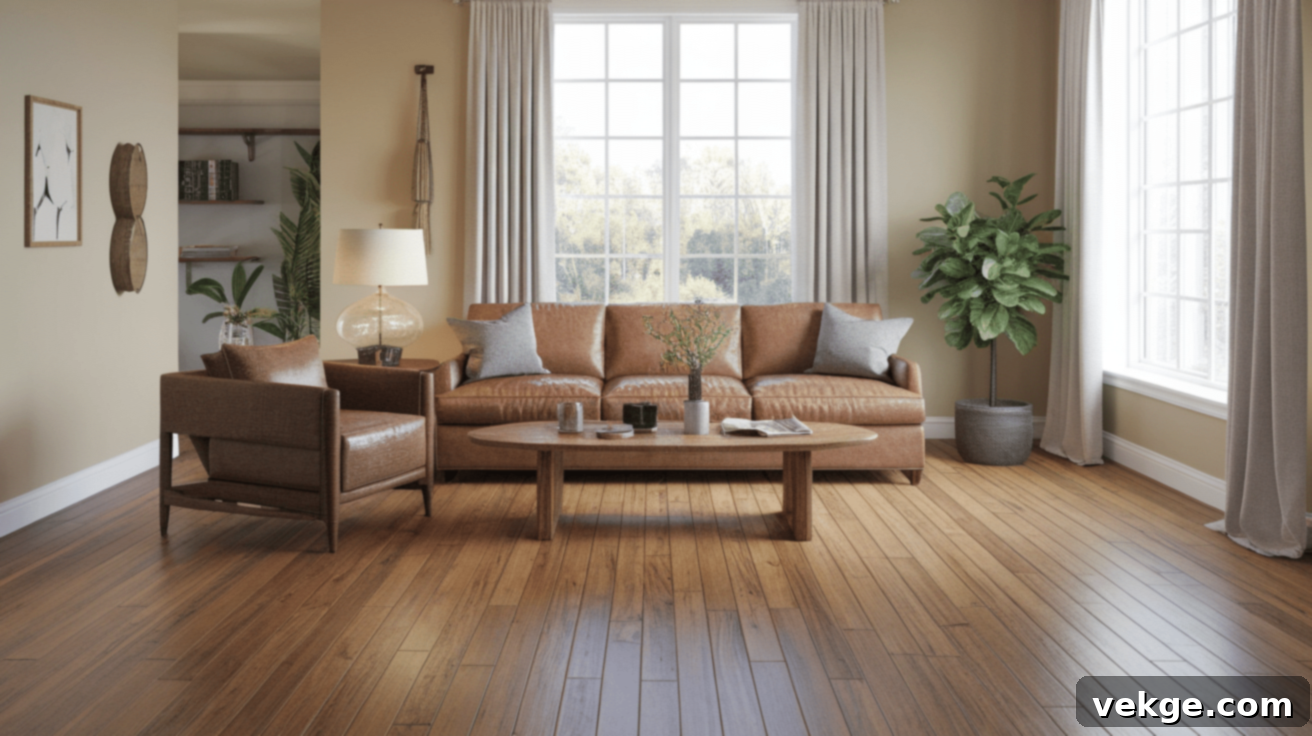
Classic hardwood plank flooring is arguably the most recognizable and widely loved wood flooring design. It features long, solid wooden boards, typically ranging from 2 to 4 inches in width, though wider options are increasingly popular. These planks can be crafted from various wood species such as sturdy oak, elegant maple, rich walnut, or warm cherry, each offering a unique grain pattern and natural color. Classic planks provide a timeless, natural, and inviting look that effortlessly complements almost any home style, from traditional to transitional.
Advantages
- Timeless Appeal: Classic planks possess an enduring aesthetic that never goes out of fashion. Their simple, clean lines serve as a versatile foundation for any decorating style, ensuring your floors remain relevant for decades.
- Exceptional Durability: Hardwood is inherently robust and, when properly installed and maintained, can withstand significant wear and tear for many years, often lasting 50 years or more.
- Variety of Choices: Homeowners have a vast selection of wood types, stains, finishes (matte, semi-gloss, high-gloss), and plank widths to choose from, allowing for a highly customized look.
- Easy to Refinish: One of the greatest benefits is the ability to sand and refinish classic hardwood multiple times. This process can remove scratches, dents, and wear, completely refreshing the floor’s appearance without needing a full replacement.
Disadvantages
- Higher Cost: High-quality solid hardwood planks can be a significant investment upfront compared to some other flooring materials like laminate or vinyl.
- Prone to Scratches and Dents: While durable, hardwood is not impervious to damage. Heavy furniture, pet claws, high heels, and dropped objects can cause visible scratches and dents, especially on softer wood species or certain finishes.
- Sensitive to Moisture: Wood is a natural material that reacts to humidity. Excess moisture can cause planks to expand, warp, buckle, or even rot over time, making them less suitable for areas prone to high humidity like bathrooms or basements.
Best Application
Living rooms, bedrooms, hallways, dining rooms, and home offices. Suitable for homes aiming for a classic, traditional, or even contemporary aesthetic where natural wood is desired.
Why I Recommend It
Classic hardwood planks are ideal for homeowners seeking a durable, natural, and inherently stylish floor that offers longevity and adaptability. They create a warm, welcoming atmosphere and offer excellent long-term value, making them a wise choice for almost any space.
2. Herringbone Pattern
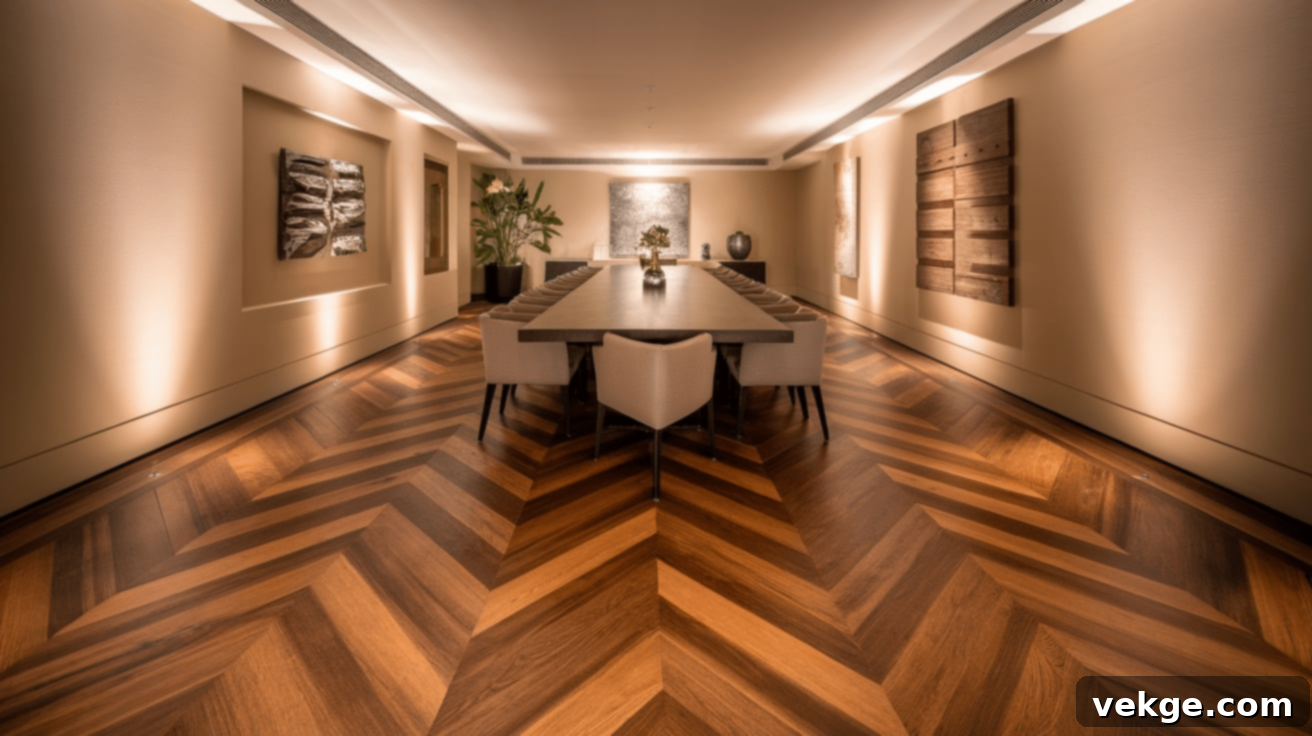
Herringbone flooring is defined by its distinctive zigzag pattern, created by arranging rectangular planks at a 90-degree angle to one another. This geometric design produces a visually dynamic and sophisticated look, adding a rich texture and a sense of movement to any space. Historically favored in opulent European estates and grand public buildings, herringbone has experienced a significant resurgence, becoming a popular choice for modern and luxurious homes seeking a touch of classic elegance.
Advantages
- Visually Appealing: The unique, interlocking pattern creates an eye-catching design that elevates the aesthetic of any room, making it a focal point.
- Illusion of Space: The angled layout of herringbone planks can trick the eye, making smaller or narrower rooms appear larger and more expansive, particularly when using lighter wood tones.
- Increases Property Value: As a high-end, intricate flooring design, herringbone adds a significant touch of sophistication and luxury, which can positively impact a property’s resale value.
Disadvantages
- Higher Installation Cost: The complexity of the herringbone pattern requires meticulous planning, precise cutting, and skilled labor, which translates to higher installation costs compared to standard plank flooring.
- Time-Consuming Installation: Due to its intricate nature, installing herringbone flooring takes considerably more time than installing straight planks, extending the project timeline.
- Can Look Busy in Small Rooms: While it can create an illusion of space, in very small or overly cluttered rooms, the prominent pattern might feel overwhelming or make the space appear too busy.
Best Application
Entryways, formal dining rooms, large open-plan living areas, master bedrooms, and modern interiors seeking a touch of classic grandeur.
Why I Recommend It
Herringbone flooring is an exceptional choice for homeowners who desire a refined, elegant, and visually striking floor that leaves a lasting impression. It’s perfect for those looking to add a luxurious and custom feel to their home.
3. Chevron Wood Flooring
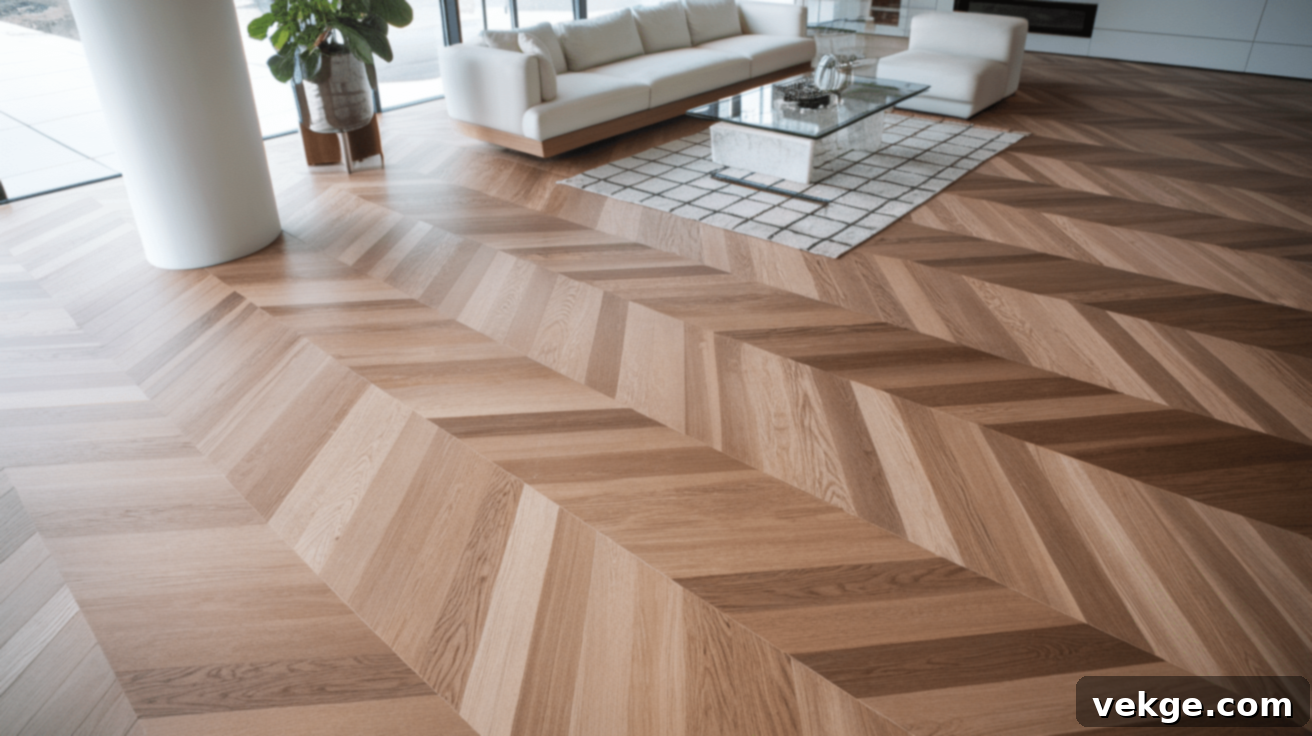
Often confused with herringbone, chevron flooring distinguishes itself with a more continuous and seamless “V” shaped pattern. This is achieved by cutting the ends of each plank at an angle (typically 45 or 60 degrees) so that they meet perfectly to form a sharp, clean point. This precise alignment creates a striking, uniform pattern that draws the eye across the room, offering a sense of fluid motion and understated luxury. Chevron flooring is a hallmark of sophisticated design, bringing a modern yet timeless touch to any space.
Advantages
- Modern and Elegant: The crisp, geometric lines of chevron flooring impart a sleek, upscale, and contemporary look, often associated with high-end Parisian apartments and boutique hotels.
- Creates Flow: The continuous “V” pattern effectively guides the eye, making rooms appear longer and more spacious, contributing to an open and airy feel.
- Works Well with Different Wood Types: Chevron can be stunningly installed using various shades or types of wood, or even with alternating colors, to create bespoke effects and unique visual depth.
Disadvantages
- Expensive Installation: The precise cutting and meticulous placement required for chevron flooring significantly increase labor costs, making it one of the more expensive installation options.
- Hard to Repair: Should a section of chevron flooring become damaged, repairing or replacing individual planks without disrupting the intricate, continuous pattern can be particularly challenging and may require specialized skills.
- Not Ideal for Small Rooms: While it can create flow, the sharp angles and strong pattern of chevron can sometimes feel too dominant or busy in very compact or overly decorated spaces, potentially making them feel smaller.
Best Application
Luxury homes, high-end urban apartments, formal living rooms, grand dining areas, and interiors seeking a chic, sophisticated, and contemporary appeal.
Why I Recommend It
Chevron flooring is the perfect choice for homeowners who desire a truly sophisticated, high-end look that exudes luxury and makes a distinct, elegant statement. It’s an investment in style that stands out.
4. Wide Plank Flooring
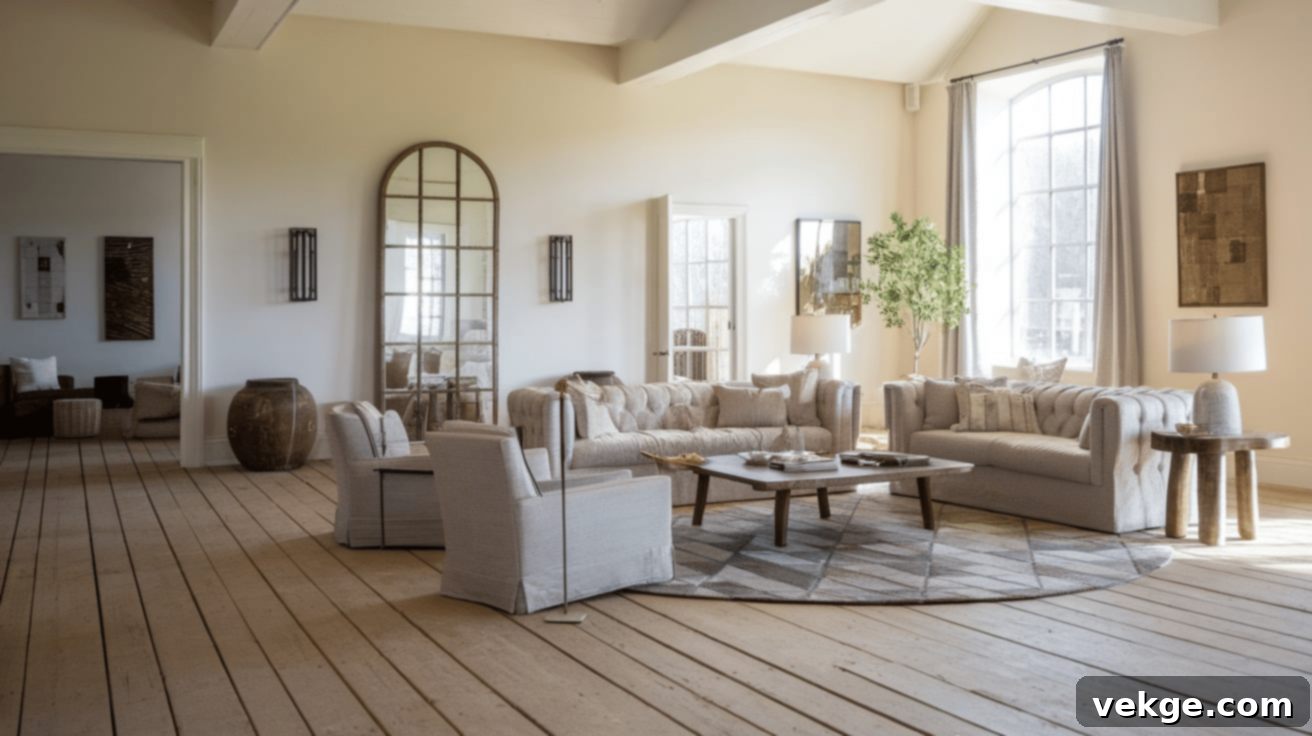
Wide plank flooring deviates from traditional narrow strips by featuring broader wooden boards, typically 5 inches or wider, with some reaching up to 10 inches or more. This design choice dramatically highlights the inherent beauty of the wood grain, showcasing its natural knots, swirls, and imperfections on a larger canvas. The expansive nature of wide planks creates a sense of spaciousness and tranquility in a room, offering a clean, uncluttered aesthetic. This style is particularly favored in rustic, farmhouse, loft, and modern minimalist homes, where simplicity and natural elements are celebrated.
Advantages
- Fewer Seams: With fewer planks needed to cover a space, wide plank flooring results in fewer seams across the floor. This creates a smoother, more seamless, and expansive visual flow, making rooms feel more open.
- Showcases Natural Wood Beauty: The broader surface area allows the natural character of the wood – its grain patterns, knots, and unique textures – to be more prominently displayed, emphasizing its organic beauty.
- Makes Spaces Feel Larger: The reduced number of visual breaks (seams) and the sweeping lines of wide planks contribute to an illusion of increased space, making them an excellent choice for open-plan areas and larger rooms.
Disadvantages
- Prone to Expansion and Contraction: Wider planks are more susceptible to the effects of humidity and temperature fluctuations, which can cause them to expand, contract, or even cup more noticeably than narrower planks, requiring careful environmental control.
- More Expensive: Producing wider, longer, and higher-grade wood planks typically requires older, larger trees and more specialized milling, which increases the cost per square foot compared to standard planks.
- Difficult to Replace: If a specific wide plank gets severely damaged, finding an exact match in terms of wood species, width, length, and finish can be more challenging due to the specialized nature of these products.
Best Application
Farmhouses, rustic-style homes, industrial lofts, open-plan living spaces, large great rooms, and minimalist interiors.
Why I Recommend It
Wide plank flooring is an excellent choice for homeowners who desire a warm, natural, and expansive look with a clean aesthetic. It’s perfect for highlighting the intrinsic beauty of wood and creating an uncluttered, serene atmosphere.
5. Parquet Wood Flooring

Parquet flooring is a traditional and artistic wood floor design characterized by small, precisely cut wooden pieces arranged in intricate geometric patterns. These patterns can range from classic squares and diamonds to more complex basketweave or mosaic designs, creating a highly decorative surface. Popularized in elegant European homes and grand chateaux centuries ago, parquet flooring has seen a resurgence in contemporary design, valued for its unique and artistic appeal that adds a sense of history and craftsmanship to modern spaces.
Advantages
- Adds Visual Interest: The elaborate and repeating patterns of parquet flooring create a captivating focal point, adding a sophisticated, stylish, and often luxurious look to any room.
- Highly Customizable: Parquet offers immense design flexibility. It’s available in a wide array of patterns, wood species, and finishes, allowing for highly personalized designs that can range from traditional grandeur to modern abstract art.
- Increases Property Value: As a high-end, artisanal flooring choice, parquet significantly enhances the aesthetic value and perceived luxury of a home, which can positively impact its market value.
Disadvantages
- Expensive: The specialized manufacturing of small, precisely cut wood pieces and the labor-intensive, intricate installation process contribute to a higher overall cost for parquet flooring.
- Difficult to Install: Achieving the perfect, seamless geometric pattern requires expert craftsmanship. Professional installers with experience in parquet are essential to ensure a precise and beautiful finish.
- Harder to Refinish: Due to the small size and varied grain direction of the individual wood pieces, sanding and refinishing parquet flooring can be more challenging and may require specialized equipment and techniques compared to solid planks.
Best Application
Traditional and vintage-style homes, formal dining rooms, grand entryways, libraries, studies, and upscale commercial spaces seeking an artistic and elegant touch.
Why I Recommend It
Parquet flooring is an excellent choice for homeowners who desire a unique, artistic, and sophisticated design that adds a deep sense of elegance, history, and bespoke craftsmanship to their interiors. It’s a statement floor that truly sets a home apart.
6. Reclaimed Wood Flooring
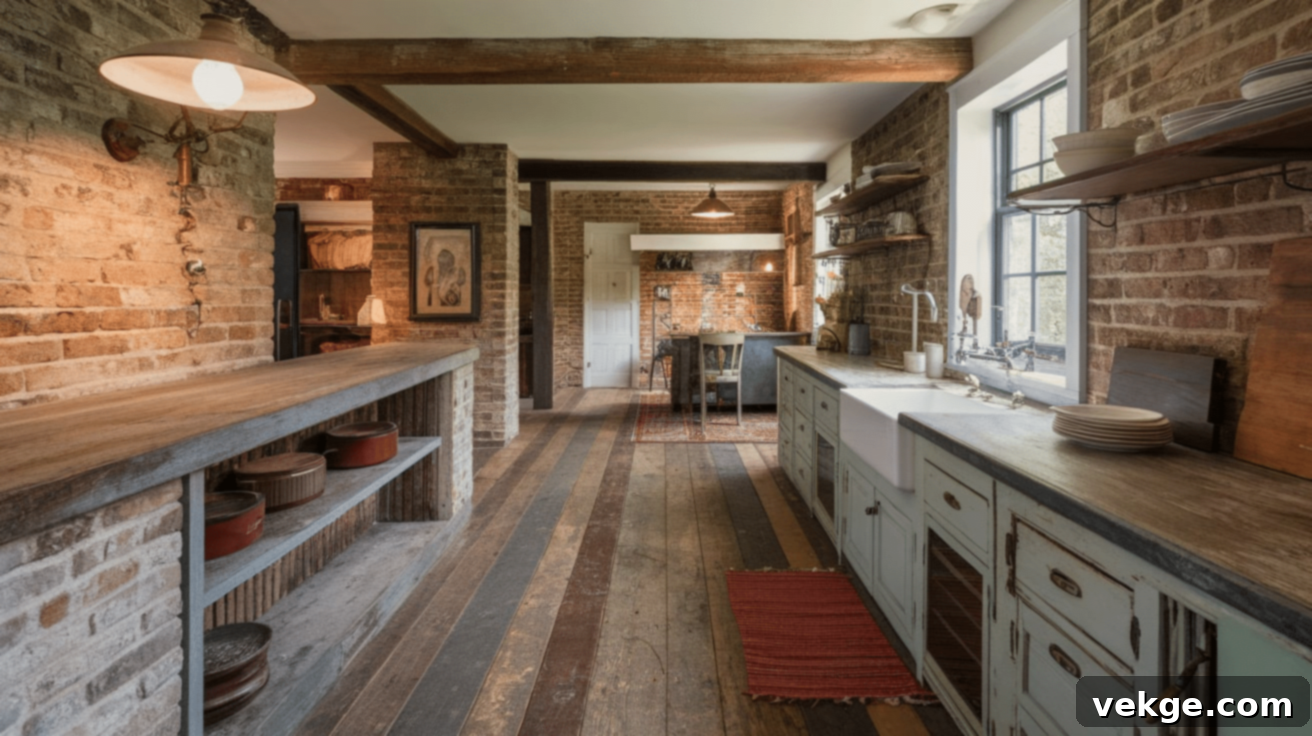
Reclaimed wood flooring is a unique and eco-conscious option crafted from timber salvaged from old structures like barns, factories, warehouses, or even underwater logs. This type of flooring is highly prized for its rich history, unique character, and inherent sustainability. Each plank tells a story, featuring natural imperfections, nail holes, saw marks, and distinct grain patterns that develop over decades or even centuries, making every floor genuinely one-of-a-kind.
Advantages
- Eco-Friendly: By repurposing old wood, reclaimed flooring significantly reduces demand for newly harvested timber, minimizing deforestation and environmental impact. It’s a truly sustainable choice.
- Full of Character: The natural aging process imbues reclaimed wood with a unique patina, deep variations in tone, and distinctive features like knots, mineral streaks, and original tooling marks that cannot be replicated by new wood.
- Highly Durable: Wood that has stood the test of time for many years, often from old-growth trees, tends to be denser, harder, and more stable than newly harvested wood, resulting in exceptionally durable flooring.
Disadvantages
- More Expensive: The process of sourcing, de-nailing, cleaning, milling, and sometimes kiln-drying reclaimed wood is labor-intensive and specialized, which often results in a higher cost per square foot.
- May Contain Imperfections: While many cherish the character, some homeowners may not appreciate the inherent imperfections of reclaimed wood, such as small cracks, variations in color, nail holes, or antique stains.
- Limited Supply: Finding a consistent or matching supply of reclaimed wood, especially for repairs or future extensions, can be challenging due to its limited and unique nature.
Best Application
Rustic, farmhouse, industrial-style homes, historical renovations, country cottages, and eco-conscious designs.
Why I Recommend It
Reclaimed wood flooring is perfect for those who are passionate about sustainability, appreciate the authentic beauty of aged materials, and desire a floor with unparalleled history, character, and a unique story to tell.
7. Distressed Wood Flooring

Distressed wood flooring is intentionally crafted to mimic the appearance of aged, worn, and weathered timber. This is achieved through various techniques that introduce artificial scratches, dents, scuffs, worn edges, and even hand-scraped textures, giving the planks a “lived-in” and antique look from the moment they are installed. This style is expertly designed to evoke a sense of history, warmth, and comfort, making it ideal for creating cozy, inviting, and character-rich interiors.
Advantages
- Hides Wear and Tear: One of the primary benefits of distressed flooring is its ability to camouflage future damage. New scratches and scuffs simply blend into the existing aged texture, making it an excellent choice for high-traffic areas or homes with pets and children.
- Rustic Charm: It instantly adds a deep sense of warmth, rustic charm, and authentic character to a space, creating an inviting and comfortable atmosphere reminiscent of old country homes.
- Low Maintenance Appearance: Because the floor already possesses an aged look, minor day-to-day wear and tear or small imperfections go largely unnoticed, reducing the visual impact of everyday life.
Disadvantages
- Not Ideal for Modern Homes: The distinct aged and rustic aesthetic of distressed flooring means it works best in specific design contexts like farmhouse, vintage, or country styles, and may clash with ultra-modern or minimalist interiors.
- Can Feel Rough: Depending on the distressing technique used (e.g., hand-scraped finishes), some distressed floors may have a more uneven or textured surface, which might not be preferred by those seeking a perfectly smooth finish.
- Limited Style Options: While available in various wood species and stains, the distressed look inherently limits the overall stylistic versatility compared to smooth, classic planks, focusing on a specific aesthetic.
Best Application
Country-style homes, farmhouse kitchens, rustic cabins, cozy cottages, vintage-inspired spaces, and high-traffic family areas.
Why I Recommend It
Distressed wood flooring is a superb choice for those who love a warm, rustic, and inviting style. It’s particularly well-suited for active households as it masterfully hides everyday wear and tear, offering both beauty and practical resilience.
8. Gray-Washed Wood Floors
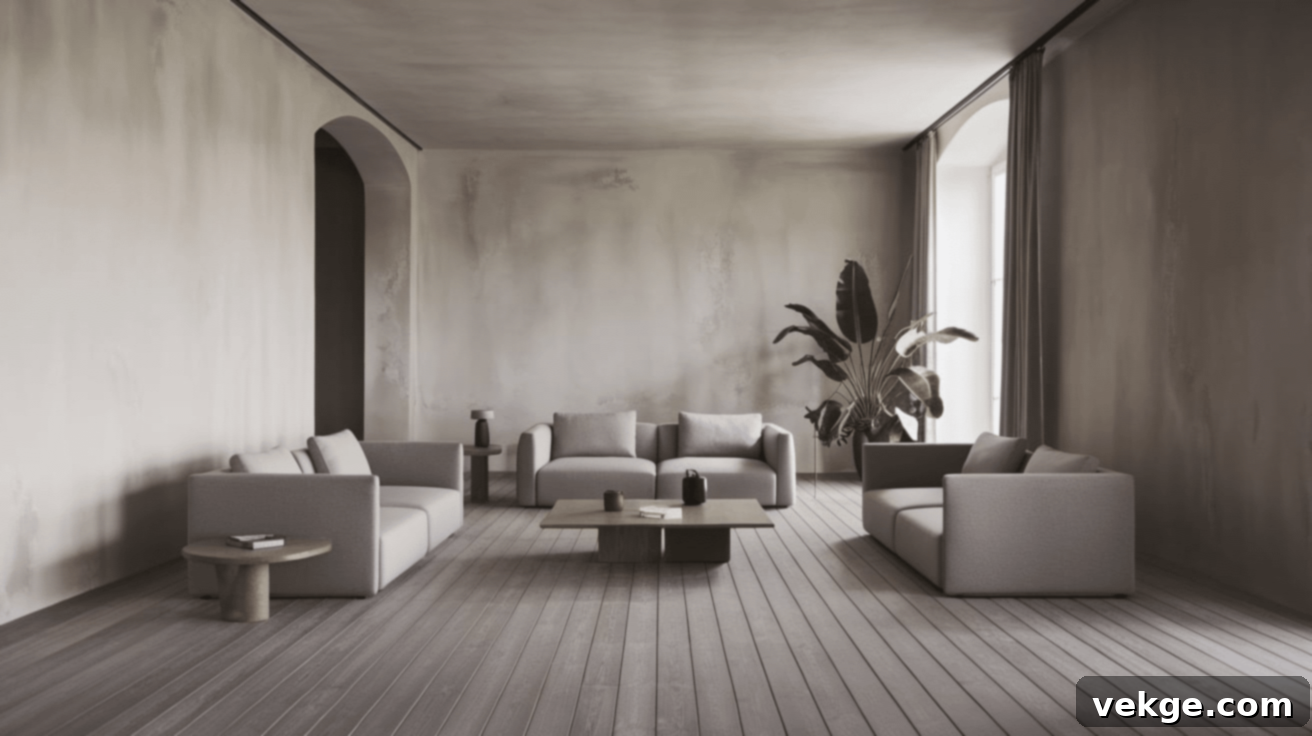
Gray-washed wood floors feature a unique finish where a translucent gray stain or wash is applied over the natural wood, allowing the grain to show through while imparting a soft, muted gray tone. This contemporary style offers a sophisticated and calming aesthetic, bringing a modern, airy, and sometimes industrial or coastal feel to any space. Gray-washed floors are particularly popular in Scandinavian, minimalist, and contemporary coastal-themed homes, providing a cool, understated backdrop for a variety of decor palettes.
Advantages
- Trendy and Stylish: Gray-washed wood is a popular choice that offers a sleek, contemporary, and fashion-forward look, perfectly aligning with current interior design trends.
- Works Well with Many Colors: The neutral gray tones provide a versatile foundation that pairs beautifully with a wide spectrum of colors, from crisp whites and pastels to bold blues and deep charcoals, making decor choices easier.
- Brightens Up a Room: Lighter gray washes, in particular, reflect light effectively, helping to make rooms feel more open, airy, and expansive, especially beneficial in smaller or naturally darker spaces.
Disadvantages
- Can Look Cold: For those who prefer warmer, more traditional aesthetics, the cool undertones of gray-washed floors might feel less inviting or even sterile if not balanced with warm accents in the decor.
- Trendy, Not Timeless: While currently very popular, some fear that gray-washed wood may be more of a trend than a timeless classic, potentially going out of style sooner than traditional wood tones.
- Shows Dirt and Dust Easily: Lighter gray finishes, much like very dark floors, can make dust, pet hair, and light debris more noticeable, requiring more frequent cleaning to maintain their pristine appearance.
Best Application
Coastal-themed homes, Scandinavian interiors, modern minimalist apartments, contemporary living rooms, and airy bedrooms.
Why I Recommend It
Gray-washed wood floors are an excellent choice for those looking to create a bright, contemporary, and sophisticated space with a touch of modern elegance. They offer a refreshing alternative to traditional wood tones and a versatile base for varied decor.
9. Dark-Stained Wood Floors

Dark-stained wood floors feature rich, deep tones such as espresso, dark walnut, mahogany, or ebony, achieved through various staining processes. These profound colors exude a sense of luxury, formality, and dramatic elegance, creating a striking contrast against lighter walls, furniture, and decorative elements. Dark wood floors are often associated with high-end, classic, and sophisticated interiors, providing a grounding effect and adding significant depth to a room’s aesthetic.
Advantages
- Elegant and Luxurious: Dark wood floors instantly elevate the perceived elegance and luxury of a space, making it feel more refined, formal, and high-end.
- Hides Stains Well: The deep tones are effective at camouflaging minor spills, dirt, and some stains, making them appear less noticeable compared to lighter-colored floors.
- Works Well in Large Spaces: Dark floors can help to visually “anchor” and add warmth to expansive, open-plan areas, preventing them from feeling too vast or cold. They create a sophisticated foundation.
Disadvantages
- Shows Dust and Pet Hair: Paradoxically, while hiding some stains, dark floors tend to highlight dust, pet hair, and light-colored debris very clearly, often requiring more frequent cleaning to maintain a polished look.
- Can Make Small Rooms Look Smaller: Dark colors absorb light, which can make compact spaces feel even more enclosed, cramped, or less airy, so careful consideration of room size and natural light is necessary.
- Scratches Are More Noticeable: Any scratches or scuffs, especially those that reveal the lighter natural wood underneath the dark stain, tend to stand out sharply against the deep finish, making them more conspicuous.
Best Application
Formal living rooms, elegant dining rooms, large master bedrooms, studies, contemporary homes with ample natural light, and spaces aiming for a luxurious, sophisticated ambiance.
Why I Recommend It
Dark-stained wood floors are perfect for those who seek a rich, dramatic, and elegant aesthetic that pairs beautifully with both modern and classic decor. They provide a powerful design statement and a sense of grounding luxury in a space.
10. Mixed-Width Planks
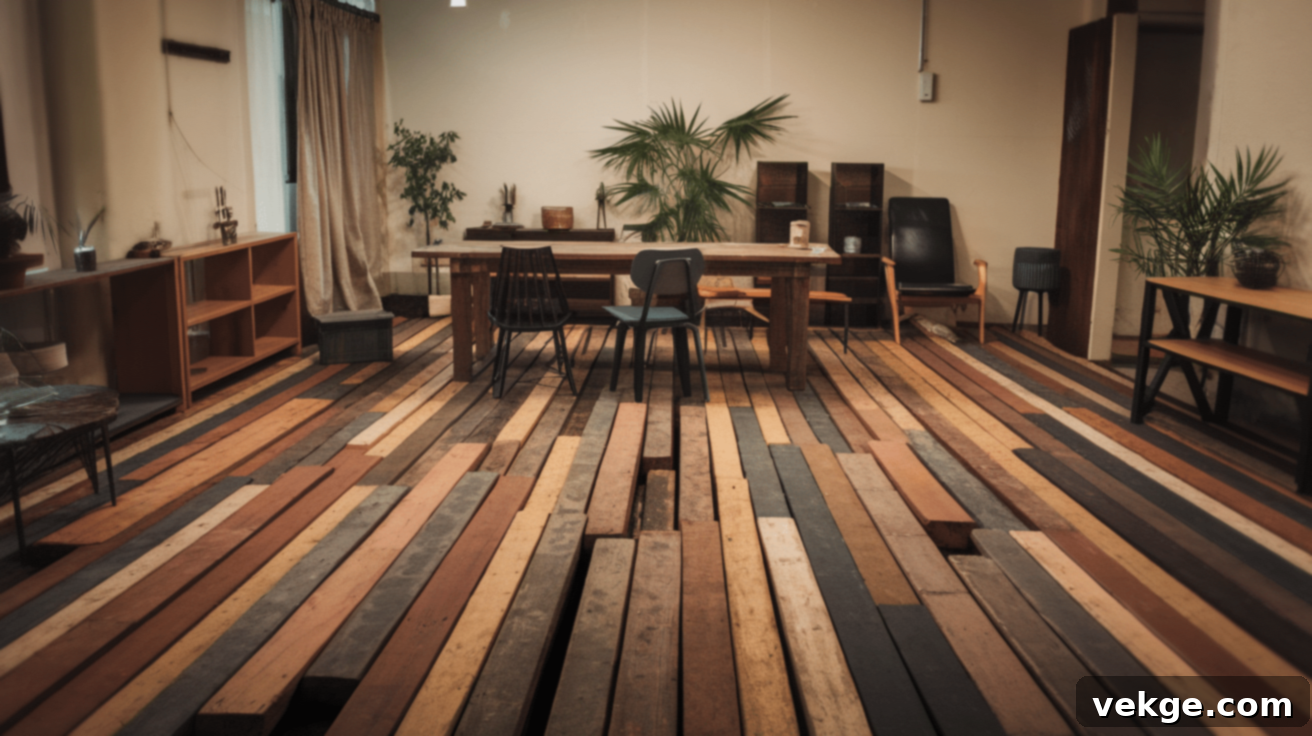
Mixed-width flooring is a design choice that utilizes planks of varying widths (e.g., 3, 5, and 7 inches) installed together to create a more natural, organic, and less uniform appearance. This approach mimics the look of old-fashioned, hand-milled floors where boards might have been cut to different sizes based on the available timber. The interplay of different widths adds significant visual interest, texture, and a dynamic flow to the floor, making each installation genuinely unique and characterful. It’s a popular choice for homes aiming for an authentic, handcrafted, or vintage feel.
Advantages
- Adds a Custom Look: The combination of various plank widths creates a bespoke, handcrafted aesthetic that immediately makes a floor feel unique and personalized, departing from standard uniform layouts.
- Feels More Natural: This style closely mimics the historical look of original wood floors found in older homes, providing an authentic, rustic, and organic feel that celebrates the natural variations of wood.
- Great for Rustic or Bohemian Styles: Mixed-width planks are perfectly suited for homes embracing rustic, farmhouse, bohemian, or eclectic interior design themes, where individuality and natural elements are key.
Disadvantages
- More Complex Installation: Laying mixed-width planks requires careful planning and a keen eye to arrange the different sizes harmoniously. This often means more time and expertise for installation compared to single-width planks.
- May Not Suit Every Style: While versatile in many rustic or eclectic settings, the distinct and varied look of mixed-width planks may not integrate well with ultra-modern, highly formal, or minimalist interior designs that prioritize sleek uniformity.
- Difficult to Replace: If a specific plank gets damaged, finding a precise replacement that matches not only the wood species and finish but also the exact width can be more challenging due to the custom nature of the layout.
Best Application
Country-style homes, bohemian interiors, rustic cottages, farmhouse living rooms, and spaces that value a unique, traditional, or eclectic aesthetic.
Why I Recommend It
Mixed-width planks are an excellent choice for homeowners seeking a one-of-a-kind floor with a rich sense of character, authenticity, and a handcrafted charm that truly makes a space feel special and lived-in.
11. Whitewashed Wood Floors
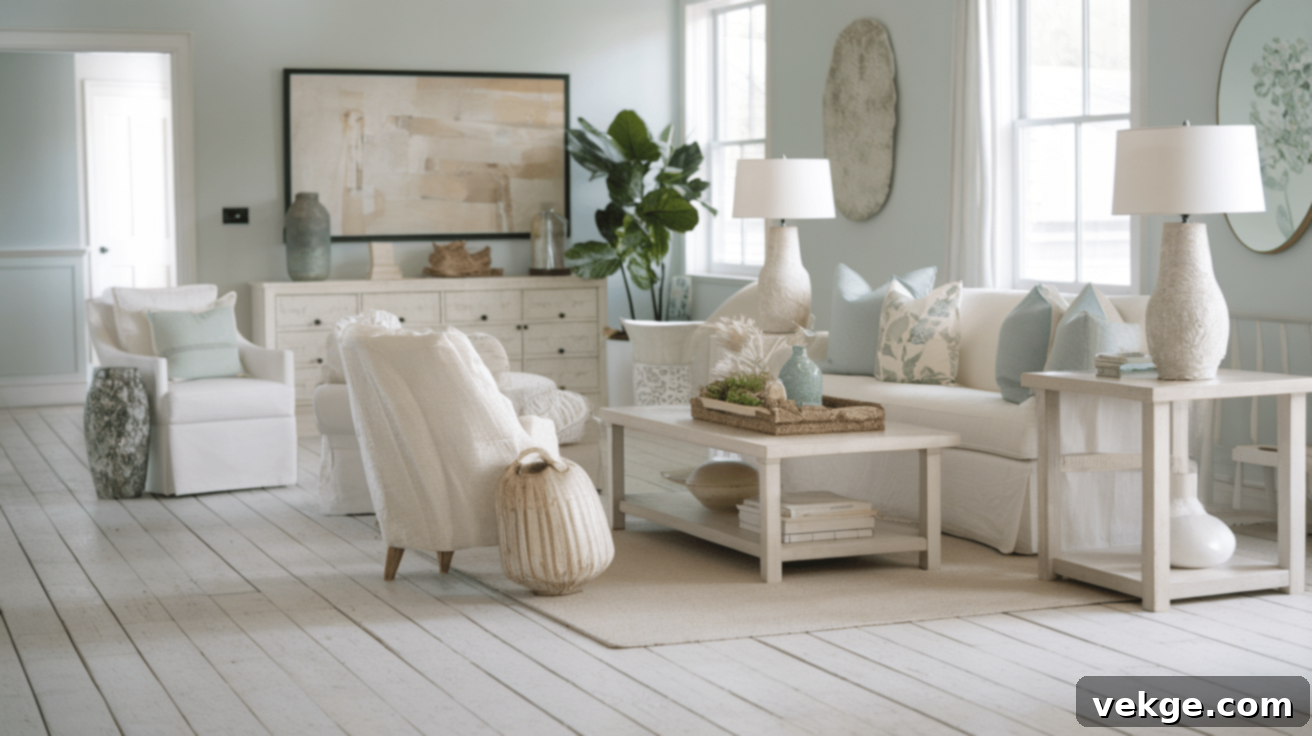
Whitewashed wood floors feature a delicate, translucent white or very light gray finish that allows the natural wood grain to subtly show through. This technique creates a soft, airy, and often beachy or coastal-inspired look, making spaces feel brighter and more expansive. Whitewashing can soften the appearance of less desirable wood tones and add a fresh, contemporary touch. This style is particularly popular in coastal homes, Scandinavian interiors, and modern minimalist spaces seeking a serene and open ambiance.
Advantages
- Brightens a Room: Whitewashed floors are highly effective at reflecting natural light, making small or naturally dark spaces feel significantly larger, airier, and more open, creating a refreshing atmosphere.
- Hides Scratches Well: The light, faded finish is remarkably forgiving when it comes to minor scratches, scuffs, and small imperfections, as they tend to blend into the light background and are less noticeable.
- Works with Many Styles: This versatile finish complements a wide array of interior design aesthetics, including Scandinavian, coastal, farmhouse, bohemian, and modern minimalist styles, offering a neutral yet characterful base.
Disadvantages
- Can Look Washed Out: If not thoughtfully styled with contrasting furniture, textures, and colors, whitewashed floors can sometimes appear too pale, dull, or lacking in depth for some preferences.
- May Require More Maintenance: While hiding scratches, very light floors tend to show dirt, dust, and dark spills more visibly than medium-toned floors, potentially requiring more frequent sweeping or cleaning.
- Not Ideal for Traditional Homes: The distinctly casual and airy aesthetic of whitewashed floors may not align with very formal, traditional, or ornate home styles, where darker, richer wood tones are often preferred.
Best Application
Coastal-themed homes, minimalist interiors, Scandinavian-designed spaces, bright and airy living rooms, bedrooms, and informal dining areas.
Why I Recommend It
Whitewashed wood floors are an excellent choice for those who desire a light, fresh, and serene flooring option that creates a relaxed, open, and inviting feel. They are perfect for brightening up spaces and embracing a modern, airy aesthetic.
Factors to Consider Before Choosing a Design
Selecting the right wood floor design involves more than just aesthetic preference. To ensure you make the best decision for your home and lifestyle, take into account these crucial factors:
- Room Size: The dimensions of your room significantly influence the perception of your chosen flooring. Lighter wood tones and wider planks can make small rooms appear larger and more open, while darker woods or intricate patterns might add coziness but can also make a tight space feel smaller. Consider how the scale of the pattern or plank will interact with the room’s footprint.
- Home Style: Your home’s existing architectural style and interior decor should guide your flooring choice. A classic hardwood plank might suit a traditional home, while herringbone could elevate a sophisticated apartment. A rustic farmhouse would benefit from wide or distressed planks, whereas gray-washed floors might be perfect for a modern, minimalist space. Aim for a design that harmonizes with your overall aesthetic.
- Traffic Levels: Consider how much foot traffic the area will receive. High-traffic zones, like entryways and living rooms, require more durable wood species (such as oak, maple, or hickory) and finishes that can withstand daily wear and tear. Softer woods or intricate patterns might be better reserved for lower-traffic areas like bedrooms or formal dining rooms.
- Budget: Wood flooring options vary widely in price, influenced by the wood species, design complexity, finish, and installation costs. Set a realistic budget beforehand to narrow down your choices and avoid overspending. Remember to factor in not just the material cost but also installation, underlayment, and potential subfloor preparation.
- Light Exposure: Assess the amount of natural and artificial light in the room. Darker floors might absorb light, making a room feel dimmer, while lighter floors reflect it, enhancing brightness. Intense direct sunlight can also cause some wood species or stains to fade over time, so consider UV protection if this is a concern.
- Pets and Children: If you have pets or young children, durability and scratch resistance become even more critical. Distressed or lighter-colored floors can be more forgiving with scratches and minor accidents, while darker, high-gloss finishes might show pet hair and scuffs more prominently.
How to Maintain Wood Floors for Lasting Beauty
Proper maintenance is key to preserving the beauty and extending the lifespan of your wood floors. Following a consistent cleaning routine and adopting preventative measures will keep them looking stunning for years to come:
- Sweep or Vacuum Regularly: Daily or every-other-day sweeping with a soft-bristle broom or vacuuming with a hard floor attachment is crucial. This removes dust, dirt, and grit that can act like sandpaper, scratching the surface of your floor over time.
- Use a Damp Mop, Not Soaking Wet: When mopping, always use a barely damp mop with a wood-specific cleaner. Excessive water is wood’s worst enemy, as it can cause swelling, warping, and damage to the finish. Wring your mop thoroughly until it’s almost dry before wiping the floor.
- Apply Protective Pads to Furniture: Place felt pads under the legs of all furniture, especially chairs, tables, and heavy pieces, to prevent scratches and dents when moving them. Regularly check and replace worn pads.
- Refinish When Needed: Depending on traffic and wear, your wood floors may need refinishing every 7-15 years. This process involves sanding down the top layer to remove scratches and reapply a fresh protective finish, restoring the wood’s original shine and smoothness.
- Keep Away from Moisture: Immediately wipe up any spills to prevent water from penetrating the wood. In humid climates, consider using a dehumidifier to prevent wood expansion, and in dry climates, a humidifier can prevent excessive shrinking and gapping. Avoid placing potted plants directly on the floor without a waterproof tray.
- Use Area Rugs in High-Traffic Zones: Place rugs or runners in entryways, hallways, and under dining tables to protect your wood floors from the heaviest wear and tear, and to catch dirt before it spreads.
Conclusion
Wood floors undeniably bring an enduring sense of warmth, sophistication, and timeless style to any home. They are not merely a practical flooring choice but an investment that adds significant charm, character, and tangible value to your property. Throughout this guide, we’ve explored a diverse range of wood floor designs, from the classic and versatile hardwood planks to the intricate elegance of herringbone and chevron, the rustic appeal of reclaimed wood, and the contemporary freshness of whitewashed finishes.
Each design presents its own unique aesthetic, advantages, and considerations, catering to different tastes, home styles, and lifestyle needs. Whether you prioritize unparalleled durability, easy maintenance, a bold design statement, or an eco-friendly option, there’s a wood floor solution perfect for you. Making the right choice involves thoughtful consideration of your room’s size, your home’s overall architectural and decorative style, the anticipated level of foot traffic, and your allocated budget.
Your flooring forms the foundation of your interior design, setting the tone for the entire space and influencing its ambiance. By taking the time to compare various designs, understand their pros and cons, and consider expert recommendations, you empower yourself to make an informed decision. A well-chosen and properly maintained wood floor is a beautiful addition that can last for many decades, enhancing your home’s comfort, appeal, and long-term value every single day.
We hope this comprehensive guide has illuminated the vast and beautiful world of wood flooring options, helping you discover the perfect design to complement your space and create the home of your dreams. Choose wisely, enjoy the natural beauty, and cherish the inviting atmosphere your new wood floors will bring!
Frequently Asked Questions About Wood Floors
Which wood floor design is the most popular?
Classic hardwood planks are consistently one of the most popular wood floor designs. Their timeless appeal, versatility, and ability to seamlessly complement a wide range of home decor styles make them a common and favored choice among homeowners. Oak, in particular, is a very popular species for classic planks due to its durability and distinct grain.
Are wood floors hard to maintain?
Generally, wood floors are considered relatively easy to maintain. They require regular sweeping or vacuuming to remove dust and grit, which prevents surface scratches. Occasional damp mopping with a wood-specific cleaner is usually sufficient for deeper cleaning. Unlike carpet, they don’t trap allergens and can be refinished periodically to restore their original shine and remove wear, making long-term care manageable.
Do wood floors increase home value?
Yes, wood floors are well-known to significantly increase a home’s resale value. Many prospective buyers view hardwood flooring as a premium upgrade and a highly desirable feature. They appreciate its durability, classic aesthetic, and easy maintenance. Homes with wood floors often sell faster and for a higher price compared to those with carpet or other flooring types.
Can wood floors be installed in a small room?
Absolutely, wood floors can be an excellent choice for small rooms. In fact, certain choices can make a small space appear larger. Lighter-colored wood floors reflect more light, enhancing the sense of openness and airiness. Simpler designs, like classic planks, can also contribute to an uncluttered feel, allowing the room to feel more expansive. Using consistent flooring throughout adjacent small spaces can also create a continuous flow, visually expanding the area.
